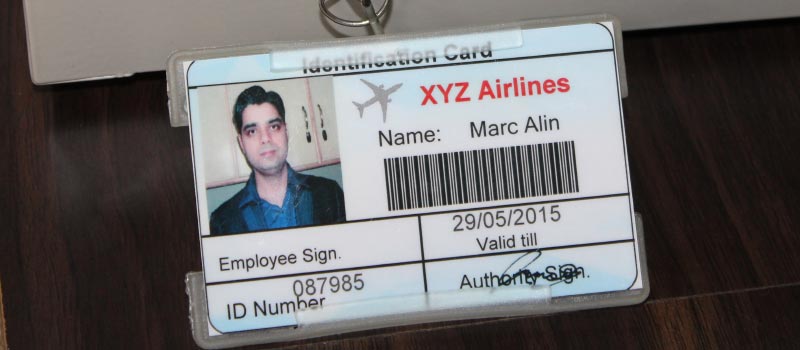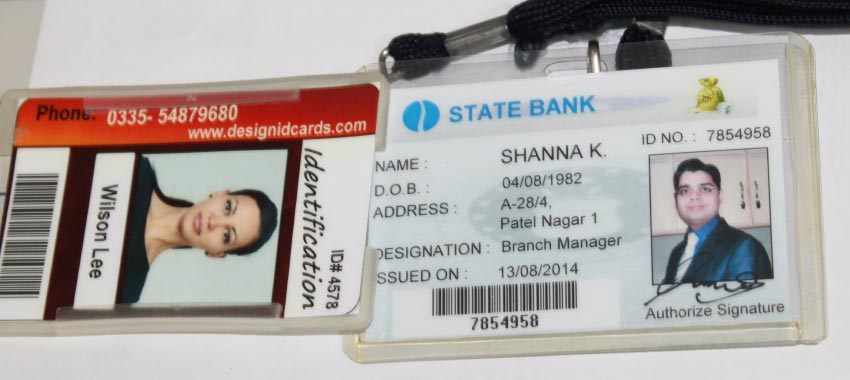The price range for ID badge design and printing services can vary depending on several factors, including the complexity of the design, the quantity of badges needed, the materials used, additional customization options, and the printing method employed. Designing a professional-looking ID badge involves considering several key elements.
By: Tech Solution
Published: 01/08/2023
Steps to Ensure your ID Badge Design is Professional-looking
⬗ Here are some detailed steps to ensure your ID badge design is professional:

- 01 Purpose and Information:
Start by clearly defining the purpose of the ID badge. Identify what information is essential to include. Common elements include the person's name, job title, company logo, and a unique identification number. Depending on the organization, you may also need to include additional details such as a photo, department, or contact information.
- 02 Clear Hierarchy and Readability:
Design your ID badge with a clear hierarchy of information. The most important elements, such as the person's name and photo, should be prominently displayed and easily readable. Use a legible font type and size for all text, ensuring it can be read from a reasonable distance. Avoid overly decorative or complicated fonts that may hinder readability.
- 03 Consistent Branding:
Incorporate your company's branding elements, such as the logo, colors, and typography, into the ID badge design. This helps establish a professional and cohesive look that aligns with your organization's visual identity.
- 04 Minimalist Design:
Keep the design clean and uncluttered. Avoid overcrowding the ID badge with excessive information or unnecessary graphics. Use ample white space to create a balanced and professional appearance. A minimalist approach tends to convey a sense of professionalism and clarity.
- 05 High-Quality Images:
If including a photograph, ensure it is of high quality and properly sized. Use a recent and professional headshot that is well-lit and clearly captures the individual's face. Avoid using casual or inappropriate images that may diminish the professional appeal of the badge.
- 06 Professional Colors:
Choose a color scheme that reflects your organization's brand and creates a professional impression. Stick to a limited palette of complementary colors to maintain visual harmony. Ensure the colors are easy on the eyes and do not clash or appear overly bright.
- 07 Material and Print Quality:
Consider the physical aspects of the ID badge. Use durable materials that can withstand everyday use without fading or getting damaged easily. Select a printing method that produces sharp and accurate results, ensuring all details are clear and legible. Matte finishes are often preferred as they reduce glare and fingerprints.
- 08 Badge Size and Shape:
Determine the appropriate size and shape for the ID badge based on its purpose and display requirements. Generally, a standard rectangular or square shape works well. Avoid unconventional or excessively large sizes that may appear unprofessional or inconvenient to wear.
- 09 Security Features:
Depending on the nature of your organization, you may need to include security features on the ID badge. These could include holograms, watermarks, barcodes, or embedded technologies like RFID chips. Consult with your organization's security or IT department to determine the necessary security measures.
- 10 User Feedback and Testing:
Before finalizing the design, gather feedback from a diverse set of individuals within your organization. Test the ID badge design on different devices and print it out at the intended size to evaluate its readability and visual appeal. Make any necessary adjustments based on the feedback received.
Conclusion: By following these steps, you can create an ID badge design that appears professional, reflects your organization's brand, and effectively communicates the necessary information. Remember to maintain a balance between aesthetics and functionality, ensuring the badge serves its purpose while being visually appealing.
Price Range for ID Badge Design and Printing Services
Here is a breakdown of the different cost components:
-
Design Services:
If you require professional design assistance for your ID badges, the cost will depend on the complexity of the design and the expertise of the designer. Design services can range from a one-time fee for creating a template or layout to an hourly rate for custom graphic design work. Prices for design services can vary significantly, starting from around $50 for a basic template to several hundred dollars for complex custom designs.
-
Printing Costs:
The printing costs are influenced by various factors, such as the printing method, the type of material used, and the quantity of badges ordered. Here are a few common printing methods and their associated costs:
-
Inkjet Printing:
Inkjet printing is a cost-effective option for small quantities of ID badges. It is suitable for printing on paper or thin plastic materials. The price per badge can range from a few cents to around $1, depending on the size and complexity of the design.
-
Dye Sublimation Printing:
Dye sublimation printing offers high-quality, full-color printing on materials like PVC or Teslin. It is a popular choice for durable and professional-looking badges. The price per badge for dye sublimation printing can range from $1 to $5, depending on factors such as size, complexity, and quantity.
-
Offset Printing:
Offset printing is commonly used for large-scale badge production. It provides high-quality, consistent results and is suitable for complex designs with special color requirements. The cost per badge for offset printing is typically lower for larger quantities, starting from around $0.50 per badge but can vary based on customization options.
-
Additional Customization:
Depending on your specific needs, additional customization options can impact the overall price. These may include:
-
Security Features:
Incorporating security features like holographic overlays, UV printing, or RFID technology can increase the cost per badge. The price for security features can range from a few cents to a few dollars per badge, depending on the complexity and level of security required.
-
Accessories:
If you require badge holders, lanyards, clips, or other accessories, their cost should be considered separately from the badge printing cost. Prices for accessories can vary, starting from a few cents to a few dollars per item.
-
Quantity:
The quantity of badges ordered is an essential factor in determining the overall price. Generally, larger quantities often result in lower per-unit costs due to economies of scale. For small quantities (e.g., less than 100 badges), the price per badge may be higher compared to larger orders.
Note: It's important to note that the above price ranges are provided as general estimates, and actual costs can vary significantly based on factors such as geographic location, vendor pricing, additional requirements, and any negotiated discounts.
Conclusion: To get an accurate and detailed cost estimate, it is recommended to reach out to ID badge printing service providers or request quotes from multiple vendors. They can provide you with specific pricing based on your requirements and help you choose the most cost-effective options for your ID badge design and printing needs.
Different Materials used for ID Badges

ID badges can be made from a variety of materials, each with its own unique properties and benefits. The choice of material depends on factors such as durability, security features, customization options, and budget. Here are some common materials used for ID badges:
- 1 Paper:
Paper badges are the most basic and cost-effective option. They are often used for temporary or disposable identification purposes, such as visitor badges or event passes. Paper badges can be printed using inkjet or laser printers, allowing for quick customization. However, they are less durable than plastic-based alternatives and may not withstand moisture or rough handling.
- 2
Biodegradable Materials:
With growing environmental concerns, biodegradable materials like cornstarch-based PLA (Polylactic Acid) or recycled paperboard are gaining popularity for ID badges. These materials are more sustainable and eco-friendly compared to traditional plastic options. Biodegradable badges can be customized with printing and security features similar to other materials.
- 3 Teslin:
Teslin is a synthetic material that combines the durability of plastic with the print quality of paper. It is a popular choice for ID badges due to its high-resolution printing capabilities and tamper resistance. Teslin badges can be printed with full-color graphics and text, and they can incorporate additional security features such as holographic overlays, microtext, or embedded RFID (Radio Frequency Identification) chips.
- 4 Composite
Laminates:
Composite laminates are made by layering multiple materials together. Typically, they consist of a PVC or polyester core covered with a thin layer of clear protective material, such as polyester or polycarbonate. This combination provides durability and tamper resistance. Composite laminates can be printed with high-resolution graphics, and they often feature additional security elements like holograms, UV printing, or laser engraving.
- 5 PVC
(Polyvinyl Chloride):
PVC is one of the most widely used materials for ID badges. It is a durable plastic material that can withstand everyday wear and tear. PVC badges are lightweight, flexible, and water-resistant. They can be customized with full-color printing, including logos, text, and images. PVC badges can also incorporate security features like holograms, UV printing, or signature panels to prevent counterfeiting.
- 6 Metal:
Metal badges offer a premium and professional appearance. They are commonly used in prestigious institutions or for high-security access control. Metal badges can be made from materials like stainless steel, brass, or aluminum. They can be engraved or etched with text and logos, and additional features like serial numbers or barcodes can be added. Metal badges are highly durable and resistant to wear, but they can be more expensive than other options.
Conclusion: It's important to consider the specific requirements and use case when selecting the material for ID badges. Factors such as durability, security, customization, and sustainability should be weighed to make an informed decision.